PinotFile: 8.9 January 22, 2010
|
Mendocino Ridge: New Frontier for Pinot Noir and ChardonnayMendocino Ridge is a newer American Viticultural Area approved in 1997, yet has some of the oldest producing vineyards in Mendocino County. The first plantings, primarily Zinfandel, were established by Italian immigrants and date to the late 1800s. The Zinfandels produced from old vines planted by turn-of-the-century Italian immigrants have been legendary. In 1988, the winery, Kendall-Jackson, proclaimed that the Mendocino Coastal Ridge was one of the world’s greatest Zinfandel regions. Today, Zinfandel is still the pride of this AVA, but the area now holds promise as California’s newest hot spot for Pinot Noir and Chardonnay. The Mendocino Ridge AVA is a non contiguous trio of ridges that is defined by vineyards at least 1,200 feet or more in elevation and within 10 miles of the Pacific Ocean. It is California’s first and only non contiguous AVA. Because of the hilly terrain of the AVA, lower elevations are not included. The ridges are above and surrounded by Coastal Zone fog, fostering the name “Islands in the Sky.” This catchy name is trademarked by Dan Dooling, owner of Mariah Vineyards, and one of the winegrowers along with Steve Alden of Perli Vineyard to successfully achieve appellation status for the region. The Manchester Ridge Vineyard, pictured below, shows the ridge top location of this vineyard and its proximity to the coastline.
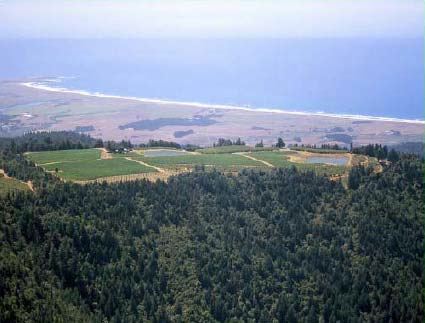 There are 262,400 acres (410 square miles, 36 miles long from north to south) within the outer boundaries of the Mendocino Ridge viticultural area, but the actual viticultural area encompasses only 87,466 acres which lie above 1,200 feet elevation. Of these 87,466 acres, approximately 1,500 to 2,000 acres (2% of the total acreage) of the ridge tops are suitable for vineyards. The side-slopes are very steep (often above 70%) and covered with timber, making them unfit for planting. The Ridge is a twisting 12 mile uphill westward drive from the Anderson Valley floor along Greenwood Road. The region is essentially a northern extension of the true Sonoma Coast viticultural region. The climate in the Mendocino Ridge is different from the Anderson Valley below. Perched above the fog and frost threat, the vineyards bask in the early morning sun, and early afternoon maritime breezes cool down the fruit, never allowing the temperatures to rise as high as the valley below. The diurnal variation during the growing season is significantly less than the Anderson Valley below (20º versus 40º). There is enough rainfall and ground water to dry farm vineyards. According to winemaker Van Williamson of Edmeades, “Mendocino Ridge grapes produce wines intense in fruit, high in acidity and structured for aging in the cellar.” Veteran winemaker, Greg La Follette, is a proponent of Manchester Ridge and notes that the high elevation of the vineyards leads to low leaf area promoting sugar storage in the berries. La Follette commented on the first Pinot Noir harvested from Manchester Ridge Vineyard in 2005 and said, “This vineyard is bound to be another Flowers Camp Meeting Ridge - even better.” The soils of the Mendocino Ridge are unique “timber” type and since the vineyards are located at the top of ridges (see Manchester Ridge Vineyard in photo above), they are well drained. In contrast, the soils of the surrounding areas are deep alluvial in type in the Anderson Valley and upland range land in type in the Yorkville region. There is plenty of sunlight but the proximity to the ocean prevents the vineyards from becoming too hot. Like the Sonoma Coast, yields are small in large part to the extremes of spring weather. Bud break tends to be early but the shoots grow very slowly due to the coolness and harvest arrives at the end of September. The first winery in the AVA was Greenwood Ridge Vineyards founded in 1980. The original Greenwood Ridge Vineyard was planted by Tony Husch in 1972 and was acquired in 1973 by Greenwood Ridge owner Allen Green. There is now some Pinot Noir planted here. Other Pinot Noir plantings in the Mendocino Ridge AVA include DuPratt Vineyard (1 acre of head-trained Pinot Noir), Manchester Ridge Vineyard (161 plantable mountaintop acres at 2,000 feet, currently 19 acres of Pinot Noir and 11 acres of Chardonnay farmed under the direction of esteemed vineyard manager Martin Mochizuki, pictured above), Mariah Vineyard (grafted over to Pinot Noir, farmed by Dan Dooling), Perli Vineyard (2,200 feet, 6.5 acres of Pinot Noir), Signal Ridge Vineyard (approx. 15 acres, farmed by Roger Scommegna) Sky High Ranch Vineyard (1,600 feet, planted in 2003, owned and farmed by Ferrari-Carano), and Valenti Vineyard (1,300 feet, 6 acres of Pinot Noir, clone 667 planted in 1999 and 3 acres of Zinfandel budded over to 115 and Rochioli selection in 2007). Wineries producing Pinot Noir and located in the Mendocino Ridge AVA include Baxter Winery, Drew, and Phillips Hill Estates. Wineries sourcing fruit from the Mendocino Ridge AVA include Arista (Perli Vineyard), Ferrari-Carano (Sky High Ranch), and Auteur, B. Kosuge, Berridge Wines, J. Jacamon, Marguerite Ryan Cellars, Russian River Vineyards, Tandem, Taft Street, and Tom Eddy (all from Manchester Ridge Vineyard). Currently, there are roughly 100 acres of Pinot Noir planted in the appellation. The one common feature that I discovered in all the wines from Mendocino Ridge was an exotic flower component in the aromatic profile. The wines show a combination of bright acidity and healthy tannic backbone that predicts longevity. Because of the limited acreage, the wines of the Mendocino Ridge AVA will always be limited in quantity, but the quality should demand your attention.
 14.1% alc., $34. Wente and Dijon clones. Aged 10 months surlees in 50% new and 50% neutral oak barrels. · Pale golden yellow color in the glass. Aromas of lemon zest, white peach and butter. Plenty of interest on the palate with flavors of pears, tangerines, lemons, roasted nuts and creme brulee. Appealing richness with bright acidity leading to a citrus-laden refreshing finish. Not as rich as the Tandem bottling but equally satisfying. Very good (+).
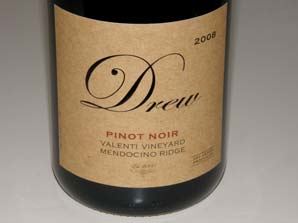 2008 Drew Valenti Vineyard Mendocino Ridge Pinot Noir 13.6% alc., 362 cases, $36. Very low yields due to severe frost resulting in intensity with relatively high acidity and firm tannins at lower sugar levels. The first Valenti Vineyard vineyard-designate Pinot Noir. Clones 114, 667. · Slightly restrained, even after an hour in the glass, showing dark cherry and berry, hay field and floral aromas. Tasty core of black cherry and black raspberry fruit which is saturating on the palate. Noticeable, but not intrusive ripe tannins with a smooth entry and follow through leading to a clean finish. This wine will continue to improve with cellaring as the tannins integrate and soften over time. If you can’t keep your hands of it now, decant. Very good.
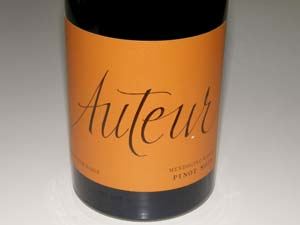 2007 Auteur Manchester Ridge Vineyard Mendocino Ridge Pinot Noir 14.1% alc., $35. · Alluring aromas of berry compote, pine sap, dried rose petals and minerals. Delicious berry fruit especially raspberry, with a sidecar of Moroccan spice, earthiness and fungiform flavor. There are ripe, grainy tannins and a subtle citrus tang on the finish. This is a wine of exceptional complexity that reveals itself in layers over time.
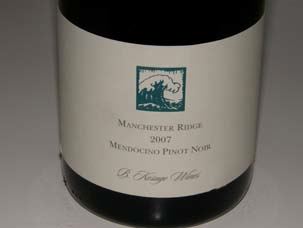 2007 B. Kosuge Wines Manchester Ridge Vineyard Mendocino Ridge Pinot Noir 14.5% alc., 300 cases, $38. · Demure but intoxicating perfume of dark berry jam, oak spice and floral bouquet. Lovely blackberry and raspberry fruit that is discreetly concentrated and clothed in silky, supple tannins. Great purity of fruit with an interesting undertone of forest floor, wood pile and mushrooms. The lingering finish keeps bringing you back. This beauty has the whole package. Will get even better with another year in bottle.
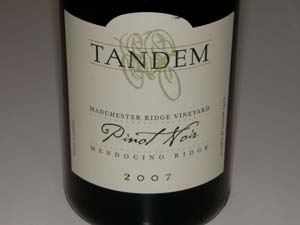 2007 Tandem Manchester Ridge Vineyard Mendocino Ridge Pinot Noir 14.1% alc., $54. · Deep reddish-purple color in the glass. Charming perfume of black cherries, plums, grapes and exotic flowers adding notes of mocha and roasted nuts over time in the glass. Darkly fruited with heaps of black cherry and plum flavors and an underpinning of savory herbs and oak. Juicy and vibrant with a polished tug of acid on the finish. A charming wine with impeccable balance. Very good.
 2006 Taft Street Mendocino Ridge Pinot Noir 14.5% alc., 326 cases, $35. Winemaker is Evelyn White. · Nuanced perfume revealing black cherries, melon, pomegranate, herbs, green tomato and oak. Very pleasing cherry and berry attack with some mocha in the background. A silky mouthfeel and impeccable balance make this wine very easy to drink. Very good.
 2006 Tandem Manchester Ridge Vineyard Mendocino Ridge Chardonnay 14.9% alc., $54. · Golden yellow color in glass. Aromas of exotic flowers, lemon, peach, pear, vanilla and seasoned oak. The flavors echo the nose with added notes of oak spice and brown butter. Clean, crisp and supple in the mouth with perfect integration of oak and alcohol and a lasting aromatic finish. An exceptional wine that is among the best Chardonnays I have every sampled from California. White lightning. Very good (+).
Savoy Vineyard: Innovation Leads to Excellence
There are special vineyards in California that have proven over time to possess exceptional terroir for Pinot
Noir. In the Anderson Valley of California, Savoy Vineyard is one such vineyard that is among the most
recognizable names in this appellation. Located northwest of the town of Philo, the vineyard lies at the base of
the hills and comprises the last knolls as well as the gently sloping terraces below them which lead eventually
to the Navarro River which flows through part of the Anderson Valley. The vineyard is protected on two sides,
one by the aforementioned hills and on the Southeast by a little rise which leads into Philo. The result is that
the vineyard, although situated in the cooler end of the Anderson Valley, is warmer than most of its neighbors.
Refer to red “A” below.
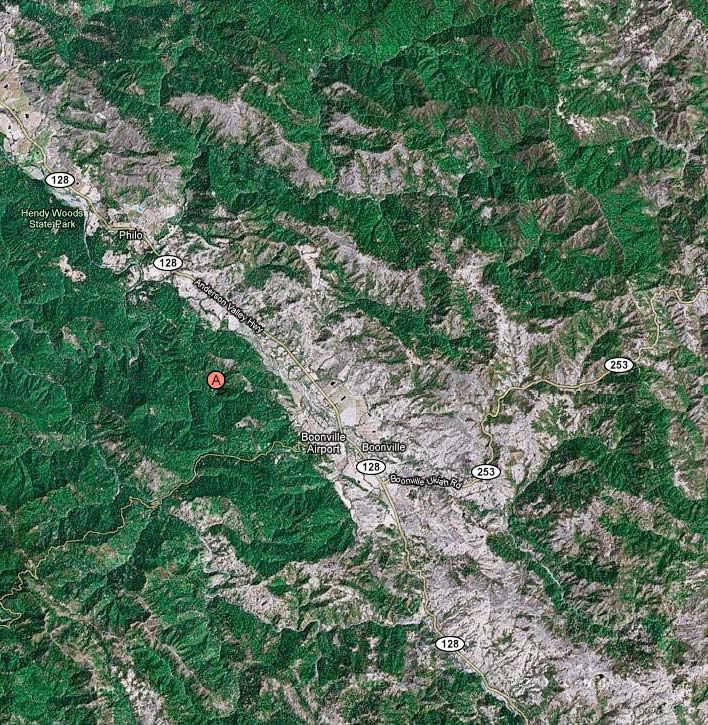 Rich Savoy and Ted Lemon (Littorai), who has crafted Savoy Vineyard Pinot Noirs since the mid 1990s and was the first to vineyard designate the site several years before anyone else, provided me with detailed information about Savoy Vineyard. Savoy Vineyard was planted by owner Rich Savoy in 1991 (10 acres, 5 acres of Pinot Noir, 5 acres of Chardonnay), in 1992 (25 acres, 10 acres of Pinot Noir, 15 acres of Chardonnay) and in 1994 (5 acres of Pinot Noir). Some areas have been replanted or grafted over since the original planting due to issues with vine health, emergence of better clones, or a desire to change the variety. Some Chardonnay acreage was grafted over to Pinot Noir so that the vineyard is now split between 29 acres of Pinot Noir and 15 acres of Chardonnay. Savoy vineyard is planted in 7’ x 5’ spacing with a modern vertical trellis system. The vineyard was part of the first wave of modern plantings in California to use both newer phylloxera-resistant rootstocks and narrower spacing with a truly vertical trellis system. The ten Pinot Noir clones are Dijon 113, 114, 115, 667, 777, 2A, Pommard, Calera, and Martini 13 and 15. Rich Savoy says, “The idea is to provide wineries with different clones to have a variety of styles, but also maintain the site style.” Like any vineyard of size, their are differences in the terroir in various portions of the site. The knolls are generally composed of sandy loams weathered from sandstone. They have moderate moisture holding capacity and moderate to very low vigor. The alluvial terraces are more darkly colored loams underlain with clay loams. The higher clay content of these terraces means that they have higher moisture holding capacity and moderate vigor and some of the areas within the terraces may soon be dry farmed. The Littorai sections contain both soil types and several clones including 114, 115, 667, 777, Pommard and Calera. For the 114, 115 and Pommard, these sections have been the same since they were originally planted in 1992. The 114 section has been dry farmed for many years, the 115 and Pommard receive minimal irrigation (between 6 to 12 gallons per vintage). Ted hopes to dry farm these sections in the next few years. Ted Lemon describes Rich Savoy as a very innovative vineyard owner. “He was open to and indeed enthusiastic about, the idea of mixed clonal plantings on a small scale before most wineries, much less most vineyardists, caught on to the idea. The same holds true for by-the-acre contracts. Rich has always had a clear understanding of the relationship between quantity and quality.” Noted viticulturist, Paul Ardzrooni, took a long term lease on the site from Rich following the 2007 vintage. Paul is now the active farmer, but he continues to work closely with Rich who contributes years of experience with the site. In the 2007 vintage, Savoy Vineyard Pinot Noir was bottled as vineyard designates by Adrian Fog, Barnett Vineyards, Benovia, Breggo Cellars, Drew, Littorai, Radio-Coteau and Roessler Cellars. I sampled each of these wines recently and tasted them blind. The Savoy Vineyard Chardonnay was sourced by Barnett Vineyards, Breggo Cellars and Radio-Coteau. Rich Savoy said the 2007 vintage "was a more intense year, but balanced, with low crop loads." The Savoy Vineyard designation on a label is a stamp of superior quality. Generally, darker fruits are evident, tannins provide good structure and age ability, and bright acidity complements the fruit. The wines are long in the mouth and vigorous with flavor and character. The wines can be serious, structured and assertive in their youth, but soften and integrate beautifully over time. I have sampled Littorai Savoy Vineyard Pinot Noirs back to 1996 and can vouch for their age ability in the hands of a talented winemaker.
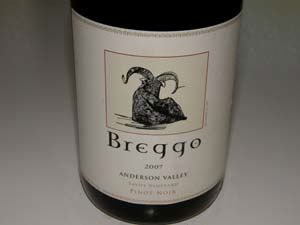 2007 Breggo Cellars Savoy Vineyard Anderson Valley Chardonnay 14.8% alc., $35. · Pale yellow color the glass. Expressive scents of pears, lemon curd and butter leading to flavors of white stone fruits, citrus and roasted nuts. The hioctane creates a plushness on the palate and the lively acidity leads to an appealing citric lift on the crisp finish. Barrel-fermented Chardonnay lovers will find this wine very appealing especially considering the price. This wine delivers a $60 experience. The 2006 vintage, which is still available in some retail markets, is equally good or better as it offers a little more richness. Very good.
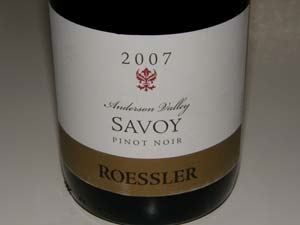 2007 Roessler Cellars Savoy Vineyard Anderson Valley Pinot Noir 14.3% alc., 273 cases, $43. · Moderately reddish-purple robe. Fruity nose showing dark berry jam and a touch of spice box. Vivid and fresh dark red fruits fill the midpalate complimented by an appealing earthiness. The tannins are dry and fine, the texture is satiny, and the finish is clean and lengthy. The balance is admirable. Relatively forward and drinkable now. Very good.
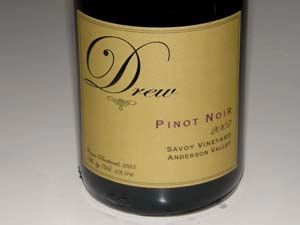 2007 Drew Savoy Vineyard Anderson Valley Pinot Noir 13.9% alc., 225 cases, $45. · Deep and rich aromas of berry tart with nuances of oak, smoke, raisin and green garden. Vivid core of raspberry fruit with bright acidity, mild astringent tannins, impressive body and viscosity, and a dry, generous finish. Tastes slightly riper than several other Savoy Pinots in this vintage. Very good.
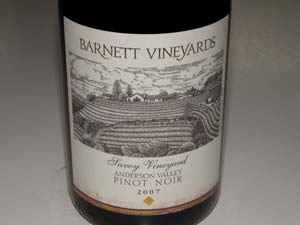 2007 Barnett Vineyards Savoy Vineyard Anderson Valley Pinot Noir 14.5% alc., 414 cases, $46.50. · Moderately dark reddish-purple robe. Redder tones of fruit predominate in this impressive wine. Hi-tone cherries and raspberries on the nose with baking spice and coconut in the background. Discreet but charming flavors of cherries and red licorice with an appealing viscous texture, supple tannins, and admirable persistence on the finish. A purist may find this wine too fruity, even a little confected, but I enjoyed it immensely. Very fruit-forward and showy at this early stage.
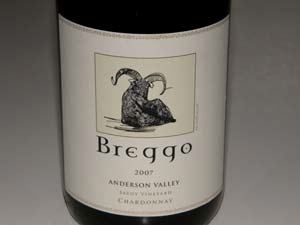 2007 Breggo Cellars Savoy Vineyard Anderson Valley Pinot Noir 14.2% alc., $49. · Restrained aromas of black cherries, dark red berries and blueberries. The cherry and berry core is withdrawn and inexpressive. Mild tannins create a soft drinking experience and the tangy finish offers a hit of citrus peel. Just not exciting now and seems to be going through a dumb phase. Decent (+).
 2007 Radio-Coteau Savoy Vineyard Anderson Valley Pinot Noir 14.7% alc., 536 cases, $50. · Dark-purple color in the glass. A riper toned nose featuring blackberries, prune, and a touch of cardamon spice. The hedonistic core of ripe, sweet berries has undertones of forest floor and woodshed. Over time, oak threatens to dominate the aromas and flavors. Time is needed to shed the healthy tannins and hopefully integrate the oak. Decent (+).
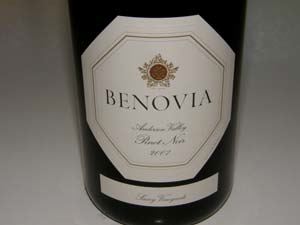 2007 Benovia Savoy Vineyard Anderson Valley Pinot Noir 14.1% alc., $55. · Intensely fruity nose with scents of blackberries, raspberries, plums and a whiff of mocha. A seamless wine with an earth-kissed dark fruit core that is discreetly rich and crisp, leading to a smooth, long and satisfying finish. Even better and highly seductive the next day from a previously opened and re-corked bottle. If you drink now, decant.
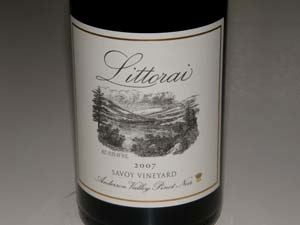 2007 Littorai Savoy Vineyard Anderson Valley Pinot Noir 13.5% alc., $60. · An impressive nose that builds and builds in intensity over time in the glass featuring black cherry fruit with a subtle hint of oak. Very tasty black cherry bombast with firm, fine-grain tannins, an appealing touch of earthiness, a silky mouthfeel and a memorable aromatic finish. This wine shows Ted Lemon’s signature: perfectly harmony. This brilliantly crafted wine continues to open in the glass over time demanding your attention. Approachable now, but patience will be rewarded.
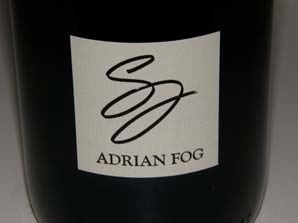 2007 Adrian Fog Savoy Vineyard Anderson Valley Pinot Noir 14.5% alc., 320 cases, $70. · Dark reddish-purple color in the glass. The nose is quite lovely initially showing plum and berry fruit with hints of oak and fennel. Over time, more floral aromas emerge, the fruit fades and a hint of alcohol appears. A medium-weighted wine with plum and blackberry fruit that is juicy, mineral-toned and earthy. Smoothly textured with minimal tannins, the wine’s firm acid backbone leads to a hi-strung, snappy finish. The most expensive Savoy bottling in 2007. Decent.
Wine Spectator SmackdownThe September 30, 2009, issue of the Wine Spectator had a lead article titled, “Best Ever California Pinot Noir.” I have often wondered when I read the reviews in these features, how my ratings would compare. I often feel that my numerical ratings would be lower for many of the wines. I decided to do a “smackdown” of several of the highly rated Pinot Noirs in this issue of the Wine Spectator. All the wines were tasted blind. I have included my usual worded review as well as the comparative scores.
2007 Papapietro Perry Peters Vineyard Russian River Valley Pinot Noir 14.5% alc., 935 cases, $44. · Subdued dark fruit, exotic spice, and marzipan on the pleasant nose. Soft and smooth in the mouth with black cherry pie, red currant, cola, and roasted nut flavors. Not quite the charm of a bottle I sampled in May, 2009. POP 89, WS 91.
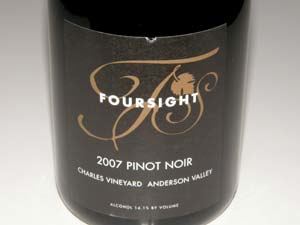 2007 Foursight Charles Vineyard Anderson Valley Pinot Noir 14.1% alc., 406 cases, $46. · Slightly confected aromas of red cherries and raspberries with a lovely accent of baking spices. Tasty redder fruit core with oak and brown spice in the background. Medium-weighted with soft ripe tannins and a tangy finish. A solid wine. POP 90, WS 88.
2007 Roessler Savoy Vineyard Anderson Valley Pinot Noir 14.3% alc., 273 cases, $46. Seven clones from different parts of the vineyard. · Penetrating scents of dark fruits with a hint of oak acquiring intensity over time in the glass. The plum and blackberry fruit flavors have a woodsy, mushroom bent. Still a bit tight with some tannins to shed, but the fruit from this vineyard really sparkles and saturates the palate. POP 91, WS 94
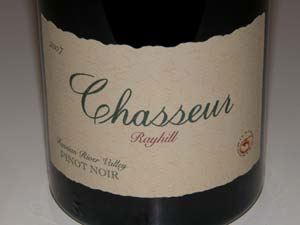 2007 Chasseur Rayhill Russian River Valley Pinot Noir 14.1% alc., 100 cases, $50. Unfined, unfiltered. · Sticking your nose in this beauty reveals layers of constantly changing aromas including black fruits, spice box, forest floor, earth, oak char, and floral accents. Big-boned but smooth and velvety in the mouth featuring a mouth filling and lingering rush of dark stone fruits and blackberries complimented by an earthy undertone. The finish is long and lush. A hedonistic wine nicely composed and balanced that aims to please. POP 94, WS 96.
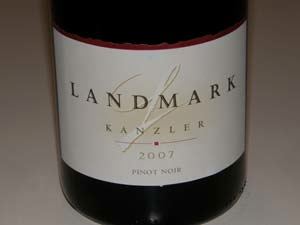 2007 Landmark Kanzler Vineyard Sonoma Coast Pinot Noir 14.9% alc., $50. · Cherries and strawberries are featured on the nose with an echo of oak and a nice hit of funkiness. The wine has pretty flavors of dark fruits with an appealing elegant presentation. The tannins are supple and the balance is spot on, resulting in a drinking experience that is easy going. POP 91, WS 94.
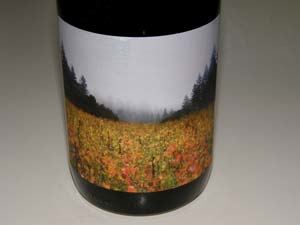 2007 Red Car Heaven & Earth La Bohéme Vineyard Sonoma Coast Pinot Noir 14.5% alc., $60. · On the nose there is initially plenty of earth and smoke with scents of ripe strawberries and cherries and a slight green note emerging over time in the glass. A seductive wine on the palate that doesn’t attack as much as it seduces with discreetly concentrated plum fruit. An accent of cola and tea adds interest. Nicely composed and balanced with a sensual satiny texture. Lacks the aromatic appeal for a higher score. POP 92, WS 97.
 2007 Foxen Sea Smoke Vineyard Sta. Rita Hills Pinot Noir 15.5% alc., 475 cases, $63. · Unfined, unfiltered. Darkly colored. Enticing perfume of crushed sweet berries with an oak accent. A voluptuous wine of copious dark berry fruit framed by firm tannins that demands your attention. Veers toward Syrah and over time in the glass becomes jammy and bit tiring. This wine makes a statement and will have fans of its Parkeresque style but its over the top for me. POP 91, WS 94.
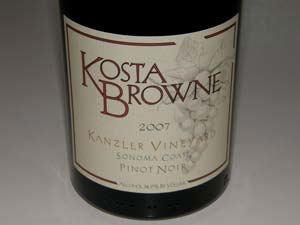 2007 Kosta Browne Kanzler Vineyard Sonoma Coast Pinot Noir 14.9% alc., 753 cases, $72. · Dark reddish-purple color in the glass. Penetrating and intoxicating aromas of dark stone fruits with a hint of strawberries and spice. The lush mouthful of black cherry and blackberry fruit is mouth coating but not jammy. Smoothly textured with fine-grain tannins and well-integrated alcohol. A fruitdriven wine from a special vineyard that is ready to drink now. POP 92, WS 95.
2007 Kosta Browne Koplen Vineyard Russian River Valley Pinot Noir 14.4% alc., 867 cases, $72. · Evolves beautifully in the glass revealing a complex nose of dark berry jam, rose petal, mocha, earth and toasted oak. Fruit-powered with a hint of cola. Firm tannic backbone with a satiny texture. Improves in the glass over time. Drink now. POP 91, WS 96
2006 Donum Estate Russian River Valley Pinot Noir 14.4% alc., $65. · Deep perfume of cherries and berries with aggressive oak toast. Tasty cherry and raspberry flavors with a woody edge leading to an echo of grapefruit peel on the bright finish. Smoothly textured with mild dry tannins. A little more oak than I like keeping it from a higher score. The oak may integrate with further cellaring. POP 90, WS 95.
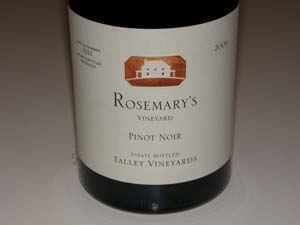 2006 Talley Vineyards Rosemary’s Vineyard Arroyo Grande Valley Pinot Noir 14.5% alc., 556 cases, $70. · Terrific aromatics picking up intensity in the glass and bursting with bright cherries and berries with a hint of oak toast. Darker stone fruits and currants on the palate veer but stop short of the ripe side. Polished and caressing in the mouth with pleasing mineral and oak notes in the background. A very stylish wine that will improve further with cellaring. POP 92, WS 94.
 2006 Kistler Silver Bolt Vineyard Cuvée Natalie Sonoma Coast Pinot Noir 14.1% alc., 1,000 cases, $90. · Moderately dark reddish-purple color in the glass. Smoky, earthy and grassy on the nose. Discreetly rich dark berry fruits with a citric note on the finish. The most striking feature of this wine is the velvety mouth feel. The flavors trump the nose at this stage. POP 90, WS 88.
Aubert Hi-Octane, Hi-Regard Pinot NoirOwner and winemaker Mark Aubert has had a distinguished winemaking career including a 12-year stint at Peter Michael in Knight’s Valley where he followed Helen Turley. Aubert succeeded Turley again several years later at Colgin Cellars. He grew up in the Napa Valley where he was more likely to drink wine and Champagne than beer. His father was a pharmacist who crafted Petite Syrah and Cabernet Sauvignon at home. Aubert graduated from California State University at Fresno with a degree in enology and minors in chemistry and viticulture. He began his winemaking career at Monticello where he made their first lees-stirred Corley Reserve Chardonnay. He subsequently struck up a friendship with Helen Turley, who was consulting for Peter Michael at the time. When the assistant winemaker at Peter Michael departed in 1989, Turley hired Aubert. In 2000, Aubert left Peter Michael to become the winemaker for Colgin and concurrently, started his own label, Aubert Wines. Aubert acquired a 7-acre Chardonnay vineyard in the Vine Hill area of the Russian River Valley in 2001 and renamed it Lauren Vineyard after his daughter. Nearby he planted another vineyard with 6 acres of Chardonnay and 1.5 acres of Pinot Noir and named it Reuling Vineyard. Aubert formed a close relationship with noted vineyardist, Ulises Valdez, and Valdez became his vineyardist and viticultural partner. Valdez crossed the border from Mexico at the age of 16, eventually becoming a U.S. citizen and now directs a successful vineyard management firm and vineyards including the UV Vineyard. Aubert crafts the wines for the Valdez label. Currently, Aubert has three vineyard designated Chardonnays (Ritchie Vineyard, Russian River Valley, Reuling Vineyard, Sonoma Coast, and Lauren Vineyard, Sonoma Coast; the Quarry Vineyard bottling was discontinued after the 2005 vintage), and two Pinot Noirs (Reuling Vineyard and UV Vineyard, both located in the Sonoma Coast appellation). Both the Reuling Vineyard and UV Vineyard, which are juxtaposed, are farmed organically, and the plantings include Old World Pinot Noir selections including a famous source in Vosne-Romanee (Calera clone). Newer plantings of 15 acres of Pinot Noir are scheduled to produce a wine in 2008. Aubert has a love for Burgundy, particularly Chardonnay, but with red Burgundies he is a fan of Dujac, Jayer, Leroy and Meo-Camuzet. Aubert’s first release under his own label was a Chardonnay from the now famous Russian River Valley Ritchie Vineyard in 2000. His initial Pinot Noir release was the 2003 Reuling Vineyard Sonoma Coast Pinot Noir. UV Vineyard Pinot Noir was added in 2004. A proprietary Bordeaux blend wine from Howell Mountain was added with the 2006 vintage. Aubert still doesn’t have his own winery, instead crafting his wine at a custom crush facility, Laird Family Estate Winery, in Napa Valley. Aubert Chardonnays are extraordinary and rank in the upper echelon of California along with Kistler, Kongsgarrd, Littorai, Marcassin and Peter Michael. The Pinot Noirs are highly praised by many wine writers who value a fruit-forward and opulent style. I love the full-throttle Aubert style in Chardonnays, but not as much in Pinot Noir. Aubert wines are truly cult wines highly coveted and tightly allocated. None of the winery’s 4,000 case annual production is sold to retail wine stores. On the secondary market, the wines sell for triple or quadruple the mailing list price of around $80 per bottle. The waiting list is filled with hopefuls who must wait years to be allocated a few bottles. 707-963-4569. Sign up for the waiting list at www.aubertwines.com. The Aubert Pinot Noirs from the 2005, 2006 and 2007 vintages reviewed below are all similar exhibiting a ripe, lush, fruit-driven hedonism with reigned-in tannins, high natural acidity and unusually high alcohol levels. Obviously there is no watering back practiced in these wines. The wines would not be considered nuanced or subtle, or classically styled Pinot Noir. They manage to hold onto their balance pretty well but as they warm in the glass, the alcohol begins to stick out and they become “boozy.” I like to use the analogy of a one-night stand: long legs, sexy and exciting on embrace, but leaving you with an empty feeling after the affair. Upfront pleasure followed by a slam down. I prefer the Reuling Vineyard bottlings in every vintage tasted, all of which show a tad more restraint. The wines were tasted two days later from a previously opened and re-corked bottle and although they held on to their pretty fruit, the alcohol was more evident on the nose. These are wines to drink young. Over time the fruit will fade, but the alcohol will never change and become a more prominent feature.
 2007 Aubert Reuling Vineyard Sonoma Coast Pinot Noir 15.6% alc., $80. · Very dark purple color. Complex nose of purple fruits, spice, sage, cola, charcoal and oak. Full-on attack of saturating plum reduction sauce on the palate with some sweetness. Fruit-driven and linear with restrained tannins and a long, dry, decadent finish. Very good.
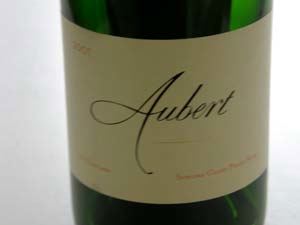 2007 Aubert UV Vineyard Sonoma Coast Pinot Noir 15.8% alc., $80. · Moderately dark reddish-purple in the glass. Scents of deep, dark berry jam, forest floor and spice with a hint of alcohol. Rich and mouth coating cherry and berry core with an appealing velvety texture. A hint of dark chocolate and cola adds interest. Hard not to like the flamboyant fruit. Liquid viagra. Very good.
2006 Aubert Reuling Vineyard Sonoma Coast Pinot Noir 15.6% alc., $80. Aged 14 months. · Moderate reddish-purple color in the glass. Intensely fruity aromas augmented by a loamy, funky and toasted oak undertone. On the palate there is slightly candied and loamy strawberry and cherry fruit that is very clean and juicy. Harmonious t n ‘a. Goes down easy. Very good.
2006 Aubert UV Vineyard Sonoma Coast Pinot Noir 15.8% alc., $80. · Deep reddish-purple robe. Slightly stewed dark fruit showing scents of raisins and prune. An underlying earthiness is evident in the aromas and flavors. Full-bodied and intense overripe fruit with a hint of tea, encased in moderate tannins leading to a dry finish. For fans of the ripe style of California Pinot Noir. Decent.
2005 Aubert Reuling Vineyard Sonoma Coast Pinot Noir 15.6% alc., $80. Aged for 14 months. · Moderate reddish-purple color in the glass. The aromas evolve with time revealing black cherries, plenty of toasted oak and Asian spices. Rich, luscious core of cherry and berry fruit with a slight smoky edge. The sandpaper tannins are restrained and the finish is fruity and dry. A linear, fruit-driven unctuous wine. Very good (-).
2005 Aubert UV Vineyard Sonoma Coast Pinot Noir 15.8% alc., $80. · Moderately deep reddish-purple color in the glass. The nose evolves over time developing attractive black cherry and blackberry fruits. Intense and fruit-driven dark cherry and berry core that is earthy and meaty. Relatively thick in the mouth with grainy tannins and good balancing acidity. Even more intensity and cajones than the Reuling bottling. Very good (-).
Along the Pinot Trail: Pinot Days Southern California 2010
The inaugural Pinot Days Southern California 2010 kicked off the Pinot Noir event season in the U.S.. About
2,200 trade members and consumers and 95 Pinot Noir producers attended the well-organized celebration of
Pinot Noir in Barker Hanger at the Santa Monica Airport. The organizers, led by Steve and Lisa Rigisch, plan
to make this an annual event.
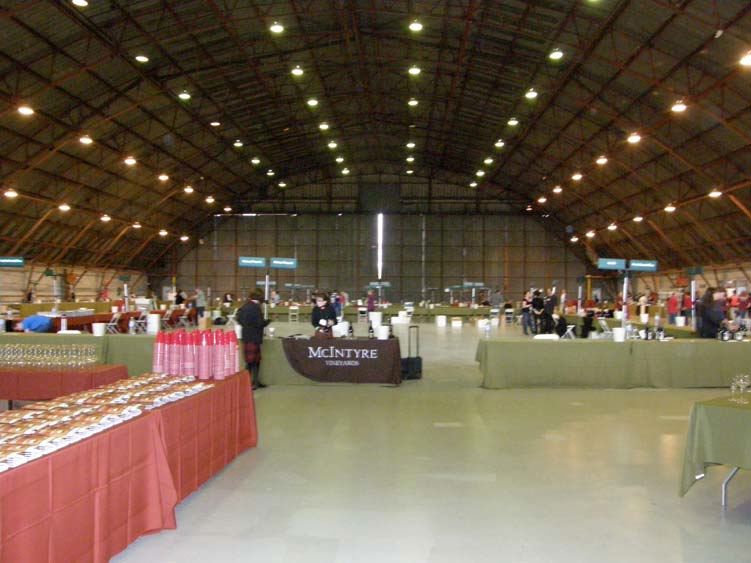 I only sampled some of the wines offered, but did come away with some impressions and a few wines that particularly stood out.
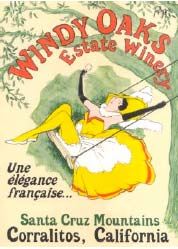 1. The three best wines I tasted were all 100% whole cluster: 2007 Native 9 (Rancho Ontiveros), 2007 Tantara Solomon Hills Vineyard, and 2007 Windy Oaks Estate Whole Cluster. Many Pinot Noir producers are now experimenting with whole cluster fermentation. Traditionally, red wines are crushed and de-stemmed before fermentation. Whole cluster fermentation refers to a fermentation of intact clusters as picked from the vine with no intervention of machines leaving the whole berries and stems intact. Stem retention may vary from 10% to 100% depending on the vintage, region and producer. I plan to present this subject in much greater detail in an upcoming issue. Stay tuned. Suffice it to say, whole cluster fermentation can add desirable aromatics, flavors and tannic structure to finished wines. I have found that Pinot Noirs with whole cluster inclusion can be exceptional.
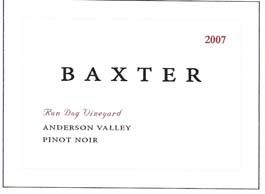 2. The winemaking mantra for vinifying premium Pinot Noir has been the use of some percentage of new French oak in the aging process. Oak can add subtle aromatic and flavor enhancements as well as contributing tannins to the finished wine. However, oak barrel aging can be overdone, robbing the wine of fruit expression and obscuring the delicate nuances that make Pinot Noir so alluring. To avoid this potentiality, some producers are severely limiting or abandoning the use of new French oak barrels. One such producer is winemaker and owner Phillip Baxter, Jr., of Baxter Winery in the Mendocino Ridge AVA of Mendocino County. At Pinot Days, he was pouring three of his latest releases, all crafted in neutral oak barrels. The 2007 Toulouse Vineyard (Anderson Valley), 2007 Red Dog Vineyard (Anderson Valley), and the 2007 Oppenlander Vineyard (Comptche, Mendocino County) Pinot Noirs were bright and fresh and pure, unadulterated expressions of Pinot Noir. The Toulouse offered an attractive richness of flavor with impeccable balance, the Red Dog had bright acidity and a memorable finish, and the Oppenlander was dark and earthy with a healthy tannic backbone. I was completely surprised after tasting these that Phillip told me they were crafted in neutral oak barrels. These wines ($45 for the Toulouse and Red Dog, $60 for the Oppenlander) deserve your attention, especially those of you who decry Pinot Noirs which reek of oak. Contact Phillip at 707-877-3727 or phillip@baxterwinery.com to acquire these special wines. Phillip also is the winemaker for Jim Ball Wines in Anderson Valley.
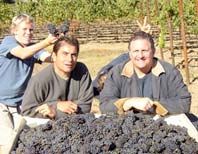 If you are a fan of the Kosta Browne style, check out the Pinot Noirs from Ketcham Estate, which in 2007 were crafted by Michael Browne. Ketcham Estate is a partnership between Steve Rigisich (left) and Mark Ketcham. The wines are sourced primarily from the 12-acre Ketcham Estate Vineyard located in the Russian River Valley just off Eastside Road. The vineyard is planted to several Dijon clones and Pommard clone. Scott Rich, noted winemaker at Talisman, will take over winemaking beginning with the 2008 vintage. The 2007 Ketcham Estate Russian River Valley bottling ($38) is 80% Ketcham Estate Vineyard and 20% O’Neel Vineyard. It is a prototypical Russian River Valley Pinot Noir aged in 30% new oak and showing the bright Bing cherry, spice and cola so typical of this region. The 2007 Ketcham Estate Reserve is a ramped up version of the same wine aged in 50% new oak and containing more Pommard clone. Both are excellent and recommended. The wines are sold through a mailing list (www.ketchamestate.com) with some retail distribution.
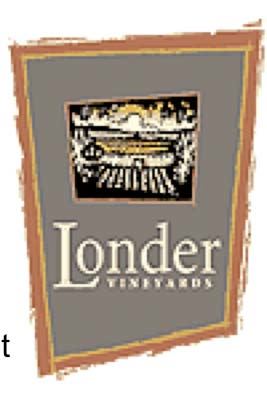 4. Londer Vineyards in the Anderson Valley is really hitting its stride. Like myself, founder Larry Londer (along with spouse, Shirlee) is a retired ophthalmologist. I know he has put his heart and soul into this winery and the wines reflect the commitment here. The winemaker is talented Richard Davis, who trained under Greg LaFollette for several years. The Londers have recently opened a tasting room on Highway 128 in Boonville. Three Pinot Noirs really impressed me: 2007 Ferrington Vineyard Anderson Valley (primarily Pommard, 228 cases, $50, lovely fruit, herbs, spice and remarkable persistence), 2007 Paraboll (591 cases, $54, Valley Foothills and Ferrrington vineyards, powerful with tannins to age), and 2006 Estate (490 cases, $48, now maturing with luscious fruit and very smooth tannins). The wines are sold primarily through a mailing list and online at www.londervineyards.com. 5. Benovia Winery has an exceptional winemaker, Michael Sullivan, who continues to craft remarkably good Chardonnays and Pinot Noirs (and Zinfandel) from estate and purchased fruit. A barrel sample of 2008 Benovia La Pommerraie Vineyard Pinot Noir was ready to go with a highly perfumed nose, smooth texture and hi-tone cherry fruit and was one of the most impressive wines I tasted at Pinot Days. I already was a fan of Benovia La Pommeraie Chardonnay from George Martinelli’s vineyard at the edge of Green Valley. Benovia wines are sold primarily through a mailing list at www.benoviawinery.com.
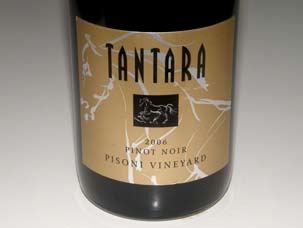 6. Jeff Fink, co-owner and winemaker at Tantara Winery, which is located at Bien Nacido Vineyard, always has an impressive lineup of Pinot Noirs to offer. Jeff is a no-BS kind of guy who is a familiar face proudly pouring at most major Pinot Noir events. I raved earlier in this feature about the half barrel of 100% whole cluster Pinot Noir from Solomon Hills Vineyard which was a striking wine in every way. The 2007 Brosseau Vineyard Pinot Noir (71 cases, $52) from the Chalone AVA was also very good. Made from the Mount Eden clone planted on a marginal site, wines from this vineyard are typically backward when young. This wine was surprisingly lush and open on the palate despite its flamboyant tannins and will match beautifully with hearty food. Tantara has a faithful mailing list following at www.tantarawinery.com.
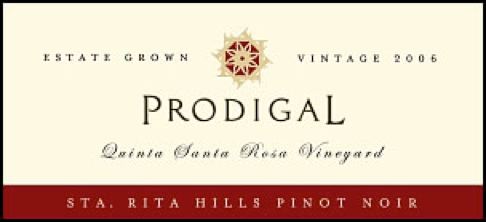 7. Stephen Russell, the winemaker at Prodigal Wines in the Santa Rita Hills, was pouring some lovely Pinot Noirs. Stephen was an early (1960) graduate of the University of California at Davis enology program and was the first formally trained enologist to be hired by E. & J. Gallo. Frustrated by corporate winemaking, he left the industry, obtained a PhD and DVM degree, and had a successful career in cancer research. In 2001 the “prodigal son” returned to his roots, and with his wife, Mary, founded Quinta Santa Rosa Vineyard and Prodigal Wines in 2001. He has gradually taken over all the winemaking duties with the 2007 vintage. His style is all about restraint and elegance and I am a fan. He was pouring several Pinot Noirs. They were strikingly well crafted and very sensibly priced, all scheduled for April release but available at 10% off pre-release pricing including: 2007 Fiddlestix Vineyard (50 cases, $35), 2007 2 Vineyards 2A (50 cases, $45, clone 2A from Rancho la Viña at the western end of the Sta. Rita Hills AVA, and clone 2A from Rio Vista Vineyard at the eastern end of the AVA, alluring rose petal nose), and 2007 Estate-Grown (92 cases, $50, remarkable aromatics). Stephen is offering 33% off a purchase of one case or more (mention Pinot Days special). You won’t find better Pinot at these prices.
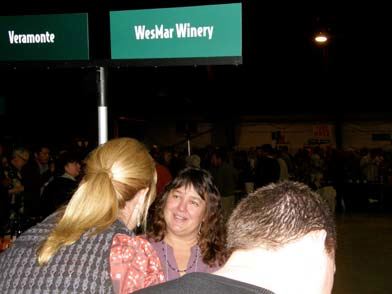 8. It was great to see Denise Selyem (photo) and Kirk Hubbard of WesMar Winery (pronounced “WesMare”) pouring their wines to a very enthusiastic response. I took a couple of my friends over to try their 2007 Sonoma Coast Pinot Noir (316 cases, $38) and they were blown away. At many wineries, the appellation blend is a poor sister to the vineyard designate wines but not so with this gem. A flat-out terrific wine for drinking now at a reasonable price. Don’t be put off by the WesMar website, www.wesmarwinery.com, as a new revision will be up soon. All the wines in their lineup are stellar (check out the huge scores in recent wine publications). 9. I find it disappointing and very poor judgment from a marketing standpoint when wineries fail to have their winemaker or owner at their station to pour their wines and answer questions. I had several attendees come to me to ask questions about wineries after they found that the pourers were woefully uninformed. The whole idea of these events is to connect with the winery principals and form that bond that makes the enjoyment of wine so much more intimate and satisfying. 10. Other wines that made an impression on me include: 2006 Belle Pente Vineyard & Winery (Willamette Valley) Murto Vineyard Pinot Noir, 2007 Inman Family Wines OGV Estate Russian River Valley Pinot Noir, 2007 Inman Family Wines Thorn Road Ranch Russian River Valley Pinot Noir, 2007 Kendric Vineyards Marin County Pinot Noir, 2007 Suacci Carciere Wines Russian River Valley Pinot Noir, and T.R. Elliott Three Plumes Hallberg Vineyard Green Valley-Russian River Valley Pinot Noir. The PinotFile is a proud sponsor of Pinot Days. Future Pinot Days events include Pinot Days San Francisco (June 2010), Pinot Days Chicago (November 2010) and Pinot Days Southern California (January 2011). Check the website, www.pinotdays.com, for updates and the latest information on the Pinot Noir scene.
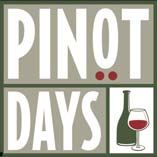
Along the Pinot Trail: 2010 Pinot ShootoutThe 8th Annual Pinot Noir Shootout finals were held recently in San Francisco. Over 250 Pinot Noirs, primarily from California, had been reduced to 64 finalists by a series of preliminary tastings. 28 esteemed wine judges met to determine the 40 finalists which will be presented to the public, trade and press at the Pinot Noir Summit in San Rafael, California on February 27, 2010. At the Summit, the public has the opportunity to vote for their favorite wines in a walk-around format in which the wines are offered blind, and the results are then compared to the scores given by the professional judging panel. Attendees will also be able to meet the winemakers and winery owners who produced each of the final wines that qualified for the Summit after they are judged and unveiled. The results are posted on the Affairs of the Vine website at www.affairsofthevine.com. Affairs of the Vine is a wine education company, specializing in corporate wine education events, interactive wine workshops, and Wine Boot Camp held at various locations in California’s wine country regions. The judging panel is composed of a diverse group of Pinot Noir loving professionals including representatives from the wine press, sommeliers, wine buyers, winemakers, restaurateurs, wine educators, and wine writers. The wines are rated using the 100-point scoring system, but the emphasis is on the copious notes that the judges create for each wine. The results of the competition are gender-based in that the male and female judges’ scores and comments are tabulated separately. At the Pinot Shootout finals I blind tasted 32 of the 64 final Pinot Noirs. The wines are judged without respect to region, vintage and price. There were a few wines that stood out and are highlighted below. Best Wine
Outstanding Wines
2007 Fulcrum Anderson Valley Pinot Noir, 14.0% alc.,100 cases, $52. 50% Hein Family Vineyard, 50% Hayley Vineyard, clones 115, 777 and Pommard, aged 14 months in 41% new oak, unfined and unfiltered, www.fulcrumwines.com. 91 2007 Hahn SLH Estate Santa Lucia Highlands Pinot Noir, 2591 cases, $29, www.hahnfamilywines.com. 92 2007 Shandel’s Oppenlander Vineyard Mendocino County Pinot Noir, 250 cases, $40, www.shandels.com. Tasted several times in past and found to be consistently stellar. Highly recommended. 93 2007 Handley Cellars Anderson Valley Pinot Noir, 14.2% alc., 4029 cases, $30, 90% Anderson Valley, primarily Handley Estate, Ferrington, Romani and Corby vineyards, aged 10 months in 30% new oak, www.handleycellars.com. 92 2007 David Bruce Winery Santa Cruz Mountains Pinot Noir, 1232 cases, $30, www.davidbrucewinery.com (website is woefully out of date). 94 Commendable Wines:
2007 TR Elliott Three Plumes Russian River Valley Pinot Noir, 150 cases, $40, www.elliottfamilycellars.com. 90 2007 Artesa Vineyards & Winery Carneros Pinot Noir, 20,664 cases, $24, www.artesawinery.com. 90 2008 CRu Appellation Series Santa Lucia Highlands Pinot Noir, 240 cases, $35, www.mariposawine.com. 90 2007 Deaver Vineyards Sierra Foothills Pinot Noir, 112 cases, $25, www.deavervineyard.com. 90 2007 Nicholson Ranch Sonoma Coast Pinot Noir, 169 cases, $42, www.nicholsonranch.com. 90 2006 Dierberg Vineyard Estate Santa Maria Valley Pinot Noir, 4,400 cases, $42, www.dierbergvineyard.com. 90 Other Pinot Noirs tasted:
2006 Row Eleven Santa Maria Valley Pinot Noir 87 2007 Cumbre of Vine Hill Barrel 31 Santa Cruz Mountains Pinot Noir 88 2008 Spy Valley Marborough New Zealand Pinot Noir 85 2007 MacMurray Sonoma Coast Pinot Noir 89 2006 Robledo Estate Los Carneros Pinot Noir 87 2007 River Road Vineyards Estate Russian River Valley Pinot Noir 88 2006 Oak Knoll Winery Red Hill Vineyard Willamette Valley Oregon Pinot Noir 85 2008 Left Edge Timberline Block Sea Ridge Vineyard Sonoma Coast Pinot Noir 86 2007 La Fenetre Le Bon Climat Santa Maria Valley Pinot Noir 86 2007 Sonoma Coast Vineyards Freestone Hills Sonoma Coast Pinot Noir 87 2006 Truchard Vineyards Napa Carneros Pinot Noir 84 2006 Belle Valle Grand Cuvee Willamette Valley Oregon Pinot Noir 85 2007 Orentano Russian River Valley Pinot Noir 85 2007 Manzoni Family Estate Santa Lucia Highlands Pinot Noir 87 2006 Mahoney Vineyards Las Brisas Vineyard Carneros Pinot Noir 86 2005 Scheid Vineyards Reserve Monterey Pinot Noir 82 2007 Pessagno Four Boys Vineyard Santa Lucia Highlands Pinot Noir 82 For tickets to the Pinot Noir Summit in San Rafael, California on February 27, 2010 visit Affairs of the Vine at www.affairsofthevine.com.
Tasting Noiregon Pinot NoirNick and Sheila Nicholas launched Anam Cara Cellars in 2001, a small family owned and operated winery primarily devoted to Pinot Noir from estate grapes. The words Anam Cara are Celtic for “friend of my soul,” and symbolize the journey that the pair have taken to make their wine. The Nicholas Estate vineyard consists of 30 acres situated between the towns of Sherwood and Newberg in the Chehalem Mountains appellation. Formerly a walnut, hazelnut and plum orchard, the vines were planted in 2001 to Dijon clones 114, 115, 667, 777 and Pommard. A further 6 acres were planted in 2008 consisting of 2 acres each of Riesling, Chardonnay and Wädenswil clone Pinot Noir. The wines are crafted by noted Oregon winemaker Aron Hess. The wines are sold through a mailing list on the website at www.anamcaracellars.com. The 2007 vintage Pinot Noirs reviewed below are lighter in color, lower in alcohol, lower in fruit intensity and impact, but more classic in style than their 2006 Anam Cara counterparts. 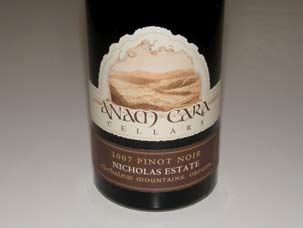 2007 Anam Cara Cellars Nicholas Estate Chehalem Mountains Pinot Noir 13.4% alc., 1,100 cases, $33. Composed of all the clones in the estate vineyard. Aged 11 months in 21% new French oak. · Hi-tone black cherry aromas are underscored by toasty oak on the nose. Tasty essence of dark cherries and berries with oak toast and mocha in the background. The tannins are supple giving the wine a welcoming drinkability. The oak tends to overshadow the fruit. Decent.
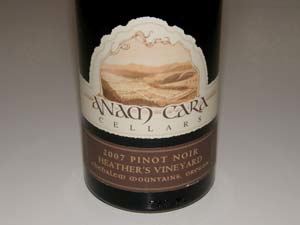 2007 Anam Cara Cellars Heather’s Vineyard Chehalem Mountains Pinot Noir 13.4% alc., 70 cases, $65.100% Dijon 114 clone. Aged 11 months in neutral barrels. · Aromas of red cherries and berries with a whiff of oak. Elegantly styled, soft and sensual focused on an earth-kissed red cherry core of fruit. The tannins are silky and the bright acidity supports a refreshing finish. May be too light in flavor intensity for this price range, but this wine is intended to be feminine in style. This style probably works better in an Oregon vintage like 2006. Decent (+).
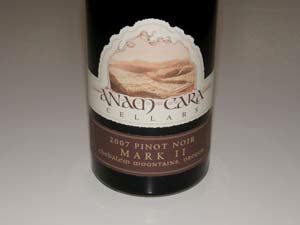 2007 Anam Cara Cellars Estate Reserve Chehalem Mountains Pinot Noir 13.4% alc., 280 cases, $45. Composed of selected barrels sourced from specific rows thinned to low yields (1.5 tons per acre). · Alluring perfume of blackberries, plum and tea with a hint of oak. Rich but not cloying array of berry fruits that are thoroughly engaging. Admirable finesse, perfect harmony and a finish that keeps you coming back for more. Great two days later from a previously opened and re-corked bottle. A keeper that is liquid nobility.
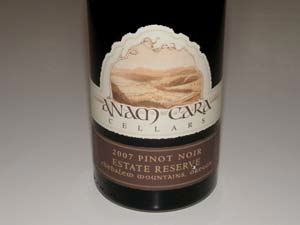 2007 Anam Cara Cellars Mark II Chehalem Mountains Pinot Noir 13.4% alc., 70 cases, $65. Aged in 51% new French oak for 11 months. 69% Pommard and 31% Dijon 777. A boldly styled wine consisting of a vineyard and barrel selection named for the owner’s son, Mark. · Brooding aromatics slowly revealing dark stone fruits, mocha java and toasted oak. Delicious attack of plums, blackberries, cola and mocha flavors that are still immature and evolving. Great stuffing and amazing persistence on the fruit-filled finish. Needs time to soften the firm tannins and fully integrate the new oak, but patience will be rewarded. Still rather closed two days later from a previously opened and re-corked bottle. Very good.
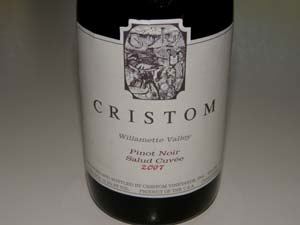 2007 Cristom Salud Cuvée Willamette Valley Pinot Noir 13.5% alc., 4 cases. This is a special bottling for the 2009 Salud Oregon Wine Auction. I bid and won a case of this wine. You can’t buy it! · Great scents of exotic Middle Eastern spice, cardamon and dark red fruits. Elegantly styled array of redder fruits that are nicely spiced. Bright and juicy with a big jolt of spiced cherry on the dry finish. Tantalizing like see-through lingerie. Crazy love.
2008 is being hailed as possibly the best vintage for Oregon Pinot Noir in this decade. The vintage was not without its challenges. The perfect spring threw a huge crop, even two to three times normal if no thinning was done. Rains arrived in September creating the potential for mold. Then hot weather returned in September and October increasing the potential for high sugars and over ripe flavors. Those wineries that harvested the grapes earlier before sugars rose brought in fresh fruits and the resulting wines appear to be stellar. The resulting wines are midway between the 2006 and 2007 vintage wines, with forward fruit typical of 2006 Pinot Noirs, combined with the acidity, brightness, and low tannins of the 2007 Pinot Noirs. The alcohols in 2008 are higher than in 2007, but still moderate Et Fille is a partnership between winemaker Howard Mozeico and his daughter, Jessica. The name, “Et Fille,” means in French “and daughter.” Howard jokes that, “Mozeico Et Fille” just wouldn’t work. The pink Et Fille labels are quite distinctive. Howard crafts small lots of primarily single vineyard Pinot Noirs that reflect the unique terroir of each individual vineyard. His vineyard sources are prime, including the well-known Maresh Vineyard in the Dundee Hills. The wines are vinified at August Cellars, a state-of-the-art gravity flow winery shared by several small producers. Production of Et Fille wines (their is also a Viognier and Rosé) is limited to about 1,500 cases and most of the wine is sold through a mailing list (www.etfille.com). I have been a fan of the wines for a few years. The prices are quite sensible considering the high quality. Magnums are available. Tasting at August Cellars is by appointment (503-449-4030). 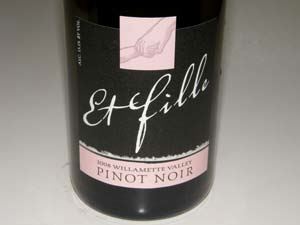 2008 Et Fille Willamette Valley Pinot Noir 13.1% alc., 931 cases, $24. A blend of seven vineyards over several sub-appellations of the Williamette Valley. Aged 10 months in 21% new oak. · Bright aromas of red fruits, decaying leaves, cardamon spice and oak toast. Respectably rich core of slightly tart red berry flavors including cranberry with soft tannins and a notable grip of acidity on the refreshing finish. A good daily drinker. Decent (+).
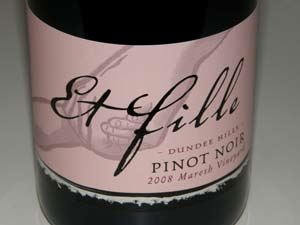 2008 Et Fille Maresh Vineyard Dundee Hills Willamette Valley Pinot Noir 12.9% alc., 100 cases, $42. Pommard clone grown at one of the oldest vineyards in the Dundee Hills. Aged 9 months in 40% new oak. · Beautiful perfume of cherries, berry jam, spice box and floral scents. The palate is not as forward as the nose but opens over time in the glass revealing dark red and blue fruits that are crisp and juicy. The tannins are supple and the acidity is vibrant. Still closed and not imposing yet, but the pedigree of the fruit shows through in the persistent finish, and this will be a terrific wine in a couple of years. Very good (+).
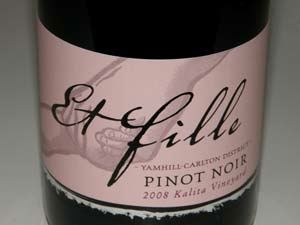 2008 Et Fille Kalita Vineyard Yamhill-Carlton District Willamette Valley Pinot Noir 13.5% alc., 206 cases, $38. The vineyard is owned by Arthur and Sherry Kalita. Pommard and Wädenswil clones. Aged 9 months in 42% new oak. · Subdued but pleasing darker stone fruit and berry aromas with a complimentary whiff of oak. Very tasty essence of black cherries with a hint of vanillin oak. Mild dry tannins, exemplary acid spine and a mouth filling presence. More rugged and intense than the Maresh. Still a little closed and will need cellaring. Very good (+).
Ken Wright is one of Willamette Valley’s most icon winemakers. Working out of his winery in Carlton, he crafts multiple single-vineyard Pinot Noirs from several appellations, including several estate vineyards that he owns. It is his Shea Vineyard bottling that I covet the most. He also produces a small amount of distinguished Chardonnay and Pinot Blanc. Wright’s Pinot Noirs typically are backward on release, requiring a few years of cellaring to develop their charms. You must be aware of this or you might be disappointed when tasting the wines shortly after release. Wright’s website emphasizes that the ideal drinking window is 2009 to 2012 for many of his wines released from 1998 to 2003. The Pinot Noirs have widespread retail distribution and are also sold as futures on the website. The winery is not open to the public. The informative website is www.kenwrightcellars.com. 2008 Ken Wright Cellars Canary Hill Vineyard Eola-Amity Hills Pinot Noir 13.3% alc., $42. The Canary Hill Vineyard is owned by Ken and Karen Wright. Planted in 1983 to Pommard clone, the vineyard is located at the southern end of the Eola Hills in Jory soil. · Hi-tone aromas of red and black fruits with backing oak and a vegetal note. The fruits are moderately concentrated and clothed in noticeably firm and wooly tannins. The smooth texture is quite pleasing and there is a hint of citric peel on the bright finish. Not as expressive as it will be, even tasting a little dilute now, but will reward the patient. Decent (+), but may merit a higher rating in a few years.
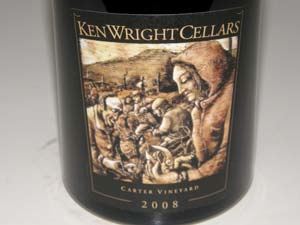 2008 Ken Wright Cellars Carter Vineyard Eola-Amity Hills Pinot Noir 13.2% alc., $42. This vineyard is owned by Jack and Kathleen Carter and managed by Mark Gould. Located in the southern end of the Eola Hills, this vineyard is primarily Nekia soils and was planted in 1983. Clones 115, 667, 777, Pommard and Wädenswil. · Needs air time to open revealing purple fruits, forest floor and oak. On the palate, the plum sauce essence is quite pleasing, yet restrained, with a supporting note of oak. The husky tannins need time to shed. Silky in the mouth. Decent (+).
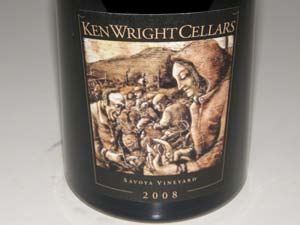 2008 Ken Wright Cellars Savoya Vineyard Yamhill-Carlton District Pinot Noir 13.5% alc., $42. This vineyard is owned by Ken and Karen Wright and managed by Mark Gould. Planting began in 1999 with five clones. · Very attractive perfume of black cherries and berries with a hint of wildflowers and oak. Juicy and lipsmacking in the mouth and fairly approachable now. Undertones of grilled meat add interest. Well-crafted with harmonious t n ‘a and a lasting finish. Very good.
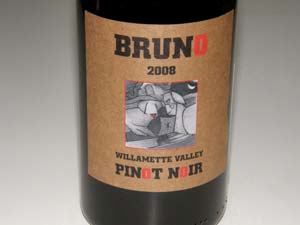 2008 Bruno Willamette Valley Pinot Noir 13% alc., $14.50. A second label for Evesham Wood. · Slightly sweet aromas of cherries, berries and violets. Mediumweighted core of berry fruit with brown spice accents, a soft texture, minimal tannins, and a clean bright finish. A daily drinker. Decent.
Styling with Kosta Browne
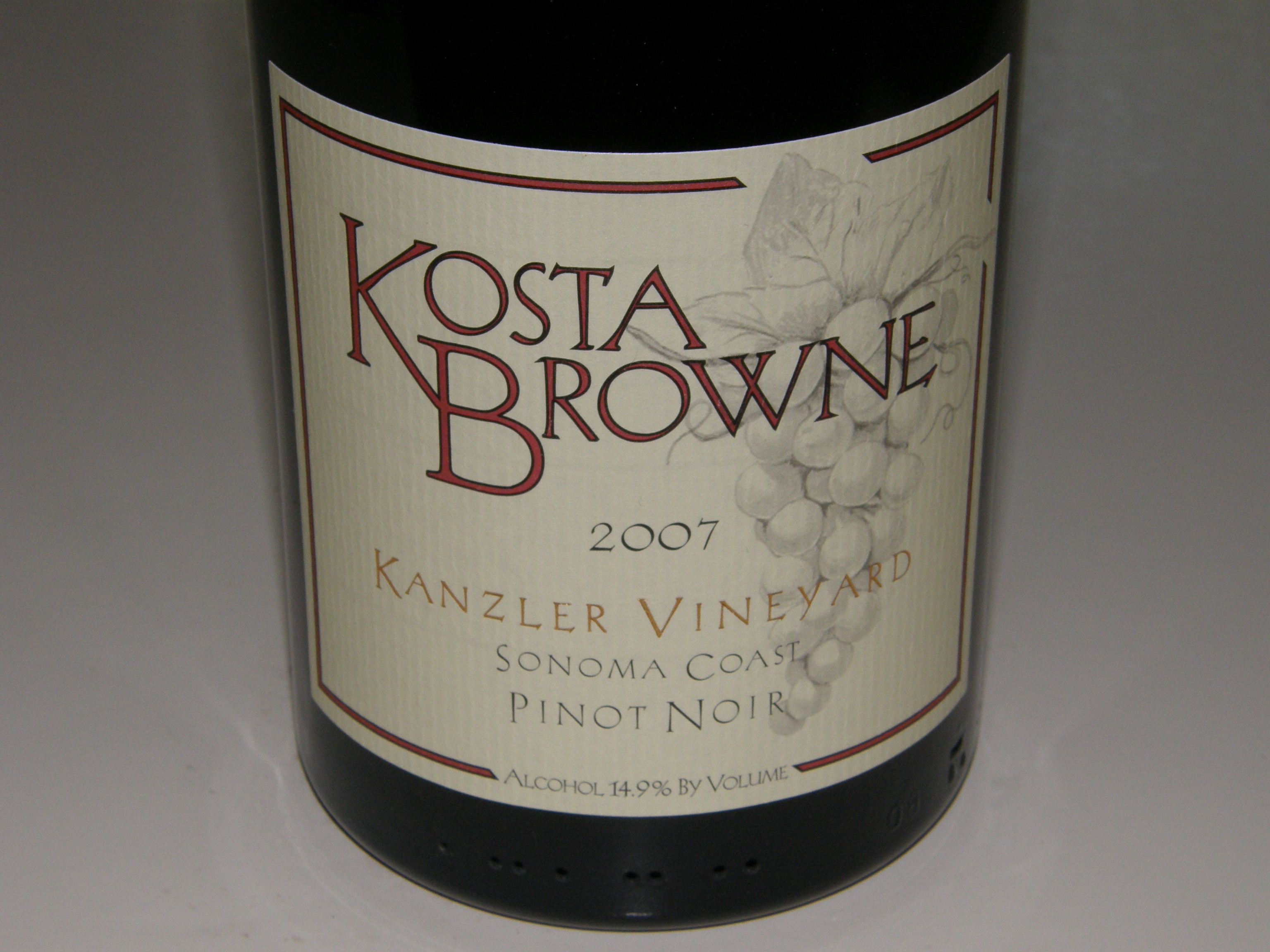
Recently, I organized a tasting of the 2007 lineup of Kosta Browne Pinot Noirs at Leatherby’s Cafe Rouge
Restaurant in Costa Mesa, California. Many in attendance are die hard fans of Kosta Browne wines and were
thrilled with the opportunity to taste the entire 2007 portfolio at one setting. There was general agreement that
the chef offered a superb menu to compliment the wines. All nine wines were poured before the dinner to allow
drinkers to sample the wines in any order and play with them with the various food courses. I do not have
detailed tasting notes on the wines as this was a social dinner with plenty of bonhomie in the air. I will report
some general impressions.
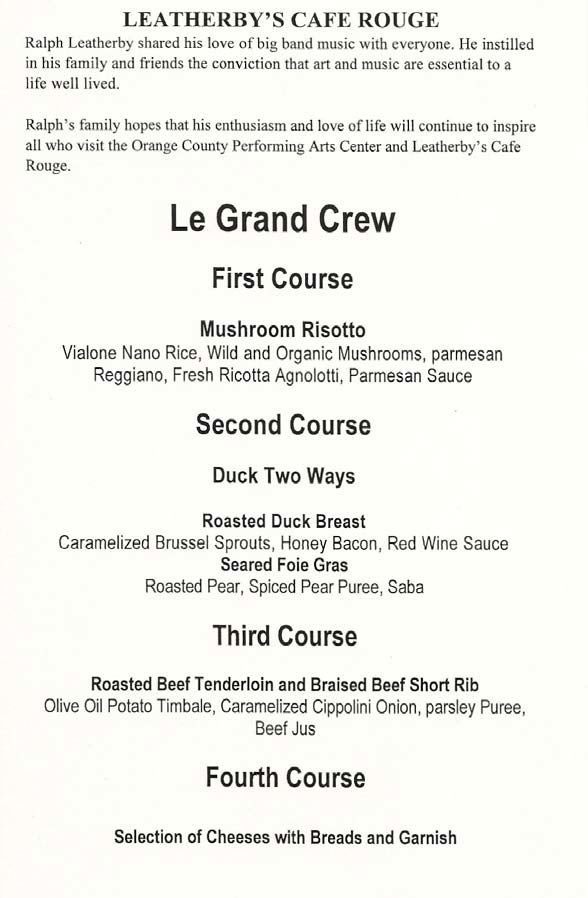 Dan Kosta was a native of Sonoma who grew up around wine. Michael Browne was born in the San Francisco Bay Area but grew up in Washington State. The pair became friends at John Ash & Co. Restaurant in Santa Rosa when Dan was the sommelier and Michael was a waiter. They developed a deep love of wine and food and the agricultural pursuit of winegrowing, and had a desire to be involved with a winery. Michael, whose goal was to make a living as a winemaker, left John Ash & Co. and became an assistant winemaker at Deerfield Ranch Winery in Sonoma Valley. He never received formal training in winemaking, but his superb palate and passion allowed him to become quickly accomplished. Before Michael left in 1997, the pair saved their tips, bought a half ton of Pinot Noir, a single barrel, and a used hand-cranked de-stemmer and crusher and produced their first vintage together. By 1999, they had attracted investment partners and started their commercial label, crafting 2,600 cases of Lake County Sauvignon Blanc. This venture proved financially unrewarding and the principals parted ways. In 2001, Dan and Michael teamed with Chris Costello and family who provided a fiscally conservative and thoughtful business plan, and success followed shortly thereafter. The 2003 vintage Kosta Browne Pinot Noirs were all awarded scores ranging from 90 to 96 by James Laube of the Wine Spectator and recognition came quickly. The mailing list quickly filled up and Kosta Browne was on every pinotphile’s radar. In September, 2009, the Kosta Browne brand was sold to Vincraft for an estimated $30 to $40 million dollars, with Dan, Chris and Michael staying on in their respective sales and marketing, management, and winemaking roles. Pictured below are partners (L to R) Dan Kosta, Chris Costello, and Michael Browne. 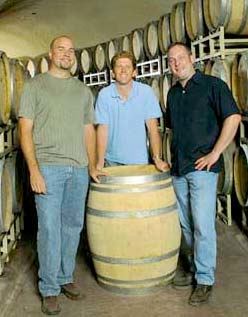 Today, Kosta Browne wines are crafted in a spacious facility in the former Vacu-Dry apple processing facility in Sebastopol. The so-called “Kosta Browne style” has received considerable praise from the press and consumers, while alienating some purists. The Pinot Noirs are a riper style, from grapes picked at advanced maturity, highly flavorful, and intensely fruity that are very drinkable young. They are not crafted with food compatibility as the foremost goal, although recent vintages work nicely with many dishes as we found out in the wine dinner reported here. In 2006, Michael Browne said of his style, “It’s nontraditional now, but in thirty years, this will be the traditional style of Pinot Noir.” The winemaking regimen for the single vineyard Pinot Noirs is as follows. Grapes are harvested relatively ripe (24.0º to 27.2º Brix), 0% to 30% whole cluster (Keefer, Rosella’s and 4-Barrel are 100% de-stemmed), cold soaked for 5 days, inoculated fermentations lasting 9 days on average with 1 to 2 punch downs per day in 1- ton and 5-ton open top stainless steel and wood vessels, barrel aged for 16 months in 48% to 56% new French oak barrels. Total annual production is 10,500 cases of Pinot Noir sold almost exclusively through the mailing list. Magnums and larger formats are also produced, but never sold to the mailing list members because of allocation challenges, and are, instead, donated to various charity auctions. Dan and Michael are very active supporters and participants in many wine related events and charities and are much respected for their generosity.
For further information, visit the informative website at www.kostabrowne.com. Kosta Browne Pinot Noirs are
available on the secondary market with the single-vineyard bottling (retail $72) selling for $100 to $160
depending on the wine and its score in the wine press.
2007 Kosta Browne Russian River Valley Pinot Noir 14.2% alc., pH 3.66, $56. Amber Ridge, Castaldi Vineyard, Copain, Keefer Ranch, Koplen, Nonella and O’Neel vineyards. 46% new French oak for 16 months. · Lightest in weight of the lineup with attractive Bing cherry aromas and flavors and bright acidity. Although the wine lacks conviction and impact, and is a bit pale in comparison to the wines to follow, it is true to the Russian River Valley theme. It is unfair to judge this wine side-by-side against the vineyard designates for they steal your attention.
2007 Kosta Browne Sonoma Coast Pinot Noir 14.5% alc., pH 3.69, $56. Dutton Manzana, Gap’s Crown, Kanzler, and Terra de Promissio vineyards. · Very dark reddish-purple color in the glass. Earthy with profuse thick, ripe, dark fruit. Richly flavored and needs food like the short ribs or mushroom risotto to tame its intense and savory nature.
2007 Kosta Browne 4-Barrel Sonoma County Pinot Noir 14.8% alc., pH 3.55, 91 cases, $72. Four special barrels from 70 different lots of Pinot Noir. Made with no respect to vineyard or appellation but in this vintage three barrels came from the Russian River Valley (Amber Ridge, Keefer Ranch, Koplen) and one from the Sonoma Coast (Kanzler). · This wine rules and was the king of the tasting. Not the most aromatic, but the most satisfying on the palate showing a velvety texture that is pure decadence. Richly flavored darker fruits coat every nook and cranny in the mouth, seemingly expanding in intensity as the attack fades to the huge finish. I loved it with the beef tenderloin. I get the feeling that this wine will evolve beautifully, reaching its apogee in another 2 to 3 years. It is a shame there is so little of this wine so that few will have the experience.
2007 Kosta Browne Amber Ridge Vineyard Russian River Valley Pinot Noir 14.6% alc., pH 3.60, 727 cases, $72. Clones 115, 667 and 777. Owned by Nickel & Nickel Winery and managed by Bacchus Vineyard Management. Located next to Gary Farrell’s Starr Ridge Vineyard. · Lacking aromatic interest but offering rich black cherry flavors and a pleasing soft texture. Couldn’t find a lot to rave about but a solid wine.
2007 Kosta Browne Garys’ Vineyard Santa Lucia Highlands Pinot Noir 14.4% alc., pH 3.71, 436 cases, $72. Pisoni clone. Third vintage from this vineyard. Cropped at 3.4 tons per acre average. · The queen of the tasting. A charming wine that exudes charisma from the enticing spiced cherry aromatics to the discreetly concentrated core of cherry and berry fruit. Very silky in the mouth with a pleasingly bright and focused quality to the fruit.
2007 Kosta Browne Kanzler Vineyard Sonoma Coast Pinot Noir 14.9% alc., pH 3.60, 803 cases, $72. Clones 115, 667 and Pommard. Cropped at 3 tons per acre. · Intensely fruity showing copious blackberry, black cherry and dark plum fruits with notes of soy sauce and cola. Well-muscled with forceful ripe tannins which are supple creating a soft mouth feel. A bit of alcohol shows up on the finish. Pairs very well with the short ribs.
2007 Kosta Browne Keefer Ranch Russian River Valley Pinot Noir 14.7% alc., pH 3.55, 615 cases, $72. This 50-acre vineyard (30 acres of Pinot Noir) is in the Green Valley appellation farmed by Marcy Keefer and Craig Strehlow. Planted to nine clones, six of which are in this wine. · Lighter and redder in color in the glass. Marvelous nose of bright Bing cherries, baking spice and cherry cola. The fruit is beautifully framed by supple tannins and lively acidity creating a satisfying finish. A knockout paired with the duck.
2007 Kosta Browne Koplen Vineyard Russian River Valley Pinot Noir 14.4% alc., pH 3.61, 867 cases, $72. 5-acre vineyard owned and farmed by Dennis and Lynn Koplen located in the Middle Reach of the Russian River Valley appellation, and planted to clone 667. Kosta Browne is the only beneficiary of fruit from this vineyard. Cropped at 3.5 tons per acre. 30% whole cluster. · Darker in all respects in the fruit and spice aromas and flavors. Interesting accents of black cherry cola and mocha. Firm, but not aggressive tannins.
2007 Kosta Browne Rosella’s Vineyard Santa Lucia Highlands Pinot Noir 15.0% alc., pH 3.72, 247 cases, $72. Pisoni clone and Dijon 828. Cropped at 3.3 tons per acre average. · The most disappointing of the vineyard-designates showing overripe aromas and flavors with a mildly flabby texture and short finish.
The group’s consensus top three? Garys’ Vineyard, Koplen Vineyard, and 4-Barrel.
Pinot Briefs
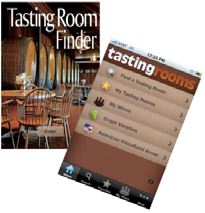 iPhone Tasting Room Finder A new application for the iPhone allows you to locate a tasting room from 3,180 locations in the United States with a few clicks. You can easily display a pop-up menu of the name, address and click-able phone numbers for each tasting room, show the user’s map position in relation to the tasting room, and generate driving directions to each tasting room selected. You can organize favorite wines you taste and even file a photograph of the label you adored. A guide to American Viticultural Areas is included. Check the iTunes App Store. Winery Numbers Continue to Increase Wine American reports that despite the recession, the number of wineries in the United States increased to 5,600 in 2008, from more than 4,700 in 2007. Many of these wineries are founded by the new wave of bankers, engineers, executives and others who are starting wineries.
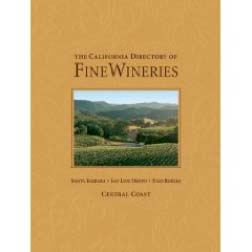 Wine Books Worth a Look The California Directory of Fine Wineries: Central Coast: Santa Barbara, San Luis Obispo, and Paso Robles written by K. Reta Badger and Cheryl Crabtree, profiles 58 wineries from Santa Barbara and San Luis Obispo Counties along with photographs of each destination. The coverage includes local attractions of interest, tasting charges, and winery events. A related volume, The California Directory of Fine Wineries: Napa, Sonoma, Mendocino, covers major wine regions north of San Francisco. Both books include beautiful photography by noted photographer, Robert Holmes, whose work is also displayed in the book, Passion for Pinot. Both books were published in 2009. Oregon wine country is covered in Wine Trails of Oregon: A guide for uncorking your memorable wine tour. Author Steve Roberts covers 200 wineries and 24 wine trails. This is the most up-to-date (published in 2009) guide to Oregon wine country and includes detailed maps and directions. All of these books are priced less than $20 at www.amazon.com. Standards for Sustainability The California Sustainable Winegrowing Alliance is a voluntary self assessment program with 68 percent of the state’s wineries and vineyards participating in the program. This month, the program took an additional step by setting minimum standards for wineries and vineyards that want to publicize their sustainable efforts to consumers. Members who achieve certification would be able to use the designation on their marketing materials and websites, but not yet on their wine labels. The certification program is sponsored by the Wine Institute and the California Assocation of Winegrape Growers. The aim is to provide the consumer with verification of “green” claims by wineries. Smokin’ Barrels A San Luis Obispo company is producing wine soaked wood chips for the barbecue. Several varieties are offered, including wood chips soaked in Pinot Noir. The chips are made from recycled French oak wine barrels that have been used in wine production for several years. For information and to location sources, visit www.smokin-barrels.com. More Low-end Wines Being Sold Consumers and restaurants are still buying plenty of wine, but most sales are in the $10 to $25 range. Sales of wines above $25 have been poor causing an oversupply and even driving down prices. Prices of grapes on the spot market have plunged as well with Pinot Noir reportedly down 43% in 2009 compared with the year prior. The beneficiaries of this trend are the large wine brands. According to Wine Spectator, the 28 brands that sold at least 2 million cases each in the United States grew by a combined 1.1 percent in sales volume, the fastest of any segment. These large brands were priced 35 percent below the industry average. AmericanWinery.comThis website claims to have the largest selection of American wine on the internet. The WineFinder allows you to select and purchase from more than 2,500 wines and the WineFinder draws on real-time data, meaning the wines listed for sale are immediately accessible. The orders are filled directly from the wineries. The variety of Pinot Noir offered is impressive with top wineries like De Ponte Cellars, Fulcrum Wines, Tudor, Roessler Cellars, Lucienne Vineyards, Foursight Wines and more, listed in descending order from most expensive to least expensive. Check it out at www.americanwinery.com. WineWeb Online Winery Tour Planning WineWeb.com has launched an online winery tour planning tool allowing visitors to plan a trip to any wine region in the world. The planning tool integrates with the winery tour appointment scheduling system and includes interactive maps and driving directions. Over 35,000 wineries are in the directory. Of course, for many boutique Pinot Noir produces you will still need to use the Prince’s Travel Directory and contact the wineries directly for an appointment, but the WineWeb tool can be a useful adjunct for larger wineries. Visit www.wineweb.com.
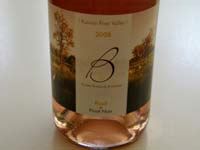 B (Bybee) Vineyards & Habitat For Sale This ultra premium producer of outstanding Green Valley Pinot Noir is for sale through Sotheby’s. The main 82-acre parcel with Demeter certified vineyards and large lake is listed for $4.99M. Two other smaller parcels with vines and a winery and tasting room site is available with the purchase of the main estate. Contact Gerald Bybee for more information at gerald@bpinot.com. First Rate Biking and Walking Tours in Wine Country Butterfield & Robinson are leaders in active luxury travel. Bike or walk at your pace (different activity levels) with every detail attended to. Eat, drink and speak with locals. Trips in Burgundy, Loire, Provence, Tuscany, and New Zealand. The company has been at it for 44 years! Consult your travel professional or visit www.butterfield.com. Raptor Ridge Builds New Winery Raptor Ridge Winery has begun work on a 10,000 case winery on their estate property outside of Scholls. The winery will also incorporate outside clients such as Atticus and Le Cadeau. Owners Scott and Annie Shulls currently craft their wines in downtown Carlton. Visit the website, www.raptorridge.com, for updates.
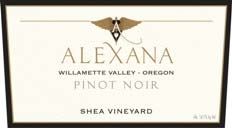 Alexana Opens Tasting Room in Carlton Alexana Winery is owned by Dr. Madaiah Revana, who also produces a highly touted Cabernet Sauvignon at his Napa winery, Revana Family Vineyard. The Alexana Winery is named after Revana’s daughter, Alexandra Revana. After enlisting the winemaking assistance of accomplished veteran Lynn Penner-Ash, Revana acquired an 80-acre property in the Dundee Hills that was planted to 16 acres of Pinot Noir and Pinot Gris. Additional Pinot Noir was planted to several clones. The first two wines, a Pinot Noir and a Pinot Gris, were released from the 2006 vintage. A new tasting room has been opened at 116 W. Main St. in Carlton. A 2007 Estate Pinot Noir ($38) and 2006 Shea Vineyard Pinot Noir ($75) are available on the website at www.alexanawinery.com. Oregon Wine Press Survey The top Oregon winey by total production (estimated figures) in 2009 was King Estate Winery (179,000 cases), followed by A to Z Wineworks/Rex Hill (135,000 cases), Willamette Valley Vineyards (129,000 cases), and Dobbes Family Estate/Wine by Joe (127,000 cases, high percentage of Wine by Joe for clients). Noted Pinot Noir producers with over 40,000 case production were Erath Vineyards, Argyle Winery, Elk Cove Vineyards, Adelsheim Vineyard, and Ponzi Vineyards.
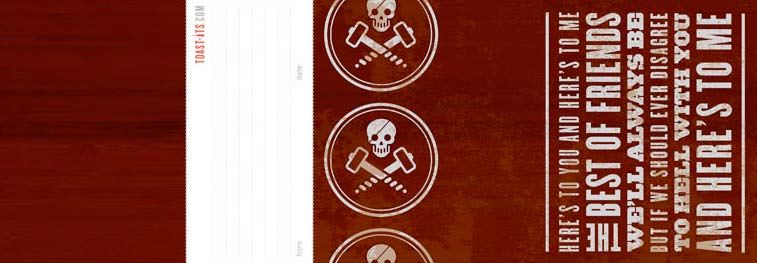 Toast-Its A fun alternative to traditional wine bags, boxes and greeting cards. Toast-Its are greeting cards that wrap around wine bottles and include an area for a personalized greeting that stays with the bottle after the rest of the wrap is removed. Priced at $3.99 with free shipping. Many styles are offered at www.toast-its.com. DIAM Research Study DIAM is the leading technical cork closure with sales of $82M in 2008, enjoying an 8.5% increase in U.S. market share in 2008. A panel of fourteen leaders from across the wine industry met with representatives of DIAM in December 2009 to structure a major research study that will provide the first quantitative data on the level of bottle variation among the best selling wines in the United States. For more information, visit www.diam-cork.com.
2010 San Francisco Chronicle Wine Competition ResultsThe reliability and usefulness of medals awarded to wines in major competitions is open to much controversy. Recent studies of competitions reported by Robert Hodgson found that the probability was high of a wine winning a gold medal in one competition and none in another. Medals seemed to be spread around randomly. Wine writer David Williams, noted in his article in The World of Fine Wine (Issue 23, 2009) titled, “Competition or Exploitation?”, “They (competitions) are certainly no more culpable than individual wine critics, many of whom promote a specious precision with their pseudo-scientific points systems. Indeed, if we are going to view the world in this pseudo-objective way, better the relative democracy of an accountable wine competition drawing on the views of many different individuals than the lordly diktats of an emperor of wine.” Paul Symington of the Symington Port family agrees and points out, “I think that the competitions with their drawbacks are a useful counterbalance to the ‘personal assessment’ judges that are inevitably very subjective.” I look at certain wine competition results as another piece of information to alert me to Pinot Noirs that might have appeal to me or the consumer. The results give me more incentive to investigate the producer and their range of wines rather than the specific gold medal winning wine. I really only pay attention to the top awards such as double gold or best in class or sweepstakes since these awards represent a firm consensus of the judging panel that the wine is deserving of special recognition. The San Francisco Chronicle Wine Competition is the largest competition of American wines. This is one of the competitions for which I pay attention to the results. 63 judges evaluated 4,913 wines from 1,500 wineries across the United States. A public tasting of the most awarded wines in the 2010 competition is scheduled at Fort Mason in San Francisco on February 20. For a full list of medal winners, visit www.winejudging.com.

Red Sweepstakes 2007 Graton Ridge Cellars Paul Family Vineyard Est Russian River Valley Pinot Noir ($40)
Up to $19.99 2008 Castle Rock Central Coast Pinot Noir $12.99 $20 to $24.99 2008 Schug Sonoma Coast Pinot Noir $24 $25 to $29.99 2007 Eddy Family Wines Elodian Vineyard Yamhill-Carlton District Pinot Noir $27.99
2007 Artisanal Wine Cellars Adams Vineyard Chehalem Mountains Pinot Noir $28 2006 Kendall-Jackson Grand Reserve Monterey Pinot Noir $25 2006 Villa Mt. Eden Bien Nacido Vineyard Grand Reserve Santa Maria Valley Pinot Noir $25
$30 to $34.99 2008 Merryvale Vineyards Carneros Pinot Noir $34.99
2008 Balletto Vineyards Winery Block Russian River Valley Pinot Noir $34 2007 Elkhorn Peak Estate Napa Valley Pinot Noir $34 2006 Lumos Wine Co Temperance Hill Vineyard Willamette Valley Pinot Noir $32 2008 S&S Carmel Pinot Noir Phoenix Vineyard Monterey County Pinot Noir $30
$35 to $39.99 2007 Hook & Ladder Winery Reserve Russian River Valley Pinot Noir $35
2008 De La Montanya Tina’s Vineyard Russian River Valley Pinot Noir $39
$40 to $49.99 2007 Graton Ridge Cellars Paul Family Vineyard Estate RRV Pinot Noir $40 and 2007
2007 Cuvaison Estate Wines Block FS Carneros Pinot Noir $45 2007 Kenneth Volk Vineyards Solomon Hills Vineyard Santa Maria Valley Pinot Noir $48 2007 Kenneth Volk Vineyards Garey Ranch Santa Maria Valley Pinot Noir $48 2007 Manzoni Estate Reserve Santa Lucia Highlands Pinot Noir $48 2008 Phillips Hill Beeson Tree Vineyard Anderson Valley Pinot Noir $42 2006 Robledo Family Winery Rancho Rincon Los Carneros Pinot Noir $40 2007 Sierra Madre Vineyard Santa Maria Valley Pinot Noir $42 2008 Summerland Winery Odyssey Thurlestone Vineyard Edna Valley Pinot Noir $45
$50 2007 Pacific Coast Vineyards Babcock Estate Sta. Rita Hills Pinot Noir $62.50
2007 Domaine Carneros Famous Gate Los Carneros Pinot Noir $68 2007 Sanford Sanford & Benedict Vineyard Sta. Rita Hills Pinot Noir $60 2006 Soquel Vineyards Lester Vineyard Santa Cruz Mountains Pinot Noir $50 2007 Terlato Family Vineyards Russian River Valley Pinot Noir $60
Noteworthy Quotes in 2009“Wine writers are writing about the superb opportunities for consumers on discounted wines, yet we see very few true bargains out in the marketplace.” Adam Lee, Siduri Wines “I think food and beverage companies should be prepared for at least several more years of more frugality from consumers.” Steven Rannekleiv, Rabebank “Ninety-eight percent of all Pinot Noir should be thrown out. The rest are the finest wines in the world.” Don Baumhefner, Copeland Creek Winery “Our business is a branded commodity business, and the sooner we can get people to enjoy wine and beer with everyday life and price it as such without all this high priced mumbo jumbo, the sooner the business will be healthy for everyone.” Fred Franzia, Bronco Wines “As always with great vintages, we only wish there was more. Mais, c’est la vie. I can’t think of a vintage in Oregon that I’ve seen like 2008, but in Burgundy, it might be similar to ’78. These wines were and still are delicious today, if you can find them.” Veronique Drouhin-Boss, Domaine Drouhin Oregon. “Critics taste too many wines in too short a time. As a result, I would expect a taster’s rating of the same wine to vary by at least three, four, five points from tasting to tasting.” Bob Cabral, winemaker at Williams Selyem “What a French vigneron strives for is typicity - to make a wine that transparently is what it is. Here, the winemaker steps aside, letting earth and sun and water and grape speak. The resulting wine becomes a distillation of place; place in a bottle.” Randall Grahm, palatepress.com. “Whatever ‘minerality’ in wine is, it is not the taste of vineyard minerals.” Alex Maltman, Professor of Geology and Earth Sciences at Aberystwyth University. “I don’t think there’s any question that San Francisco has the best winemaking weather in the world.” Fritz Maytag, York Creek and Anchor Brewing Company “If we’re reduced to pandering to a demographic (Generation Y) that treats wines with as much reverence as their constant and perpetual practice of being in the moment tethered to text messaging and Facebook, we should immediately start writing the obituary for wine as a beverage of distinction.” Mutineer Magazine “Biodynamics is an art form, and no art forms are judged scientifically. I mean, how many scientific studies were done on Van Gogh?” Blair Campbell, winemag.com “The difficult art of wine tasting requires a considerable measure of humility.” Neil MacCallum, Dry River, Martinborough, NZ, The World of Fine Wine “I estimate that some 45 percent of premium California wineries already use either reverse osmosis or the spinning cone to fine-tune (that is, reduce) their alcohol levels.” Clark Smith, Vinovation. “The issues I find most problematic with wine competitions is that they seek to impose a standard of objectivity on wine, and that they ask us to view wine in terms of the best and the greatest. Now, in an ideal world, the words ‘greatest’ and ‘best’ would be excised from the critical lexicon.” David Williams, The World of Fine Wine “Just when you think California Pinot Noir can’t get much better, it does.” James Laube, Wine Spectator “Great Pinot Noir is like explaining sex to a virgin.” Prince |